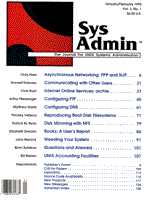
Sidebar: Device Issues
When you use the dd(1) command to copy data from one device to another, you must pay attention to device block sizes. If the boot-disk and tape drive block sizes are different, as they are in this example, (8192 bytes/block for the boot-disk vs. 1024 bytes/block for the tape), dd(1) requires blocking conversion. This is accomplished by specifying the input block size (ibs), output block size (obs), and synchronization in the conversion (conv=sync). When copying between similar devices, specifying the block size is all that is required. For example, to use dd(1) to copy one file from tape to tape, you would simply use:
dd if=/dev/nrmt0h of=/dev/nrmt1h bs=1024
Check your disk description file (/etc/disktab in ULTRIX) for the block size of your disks. Tape block sizes can be found in the man(1) pages for your SCSI magnetic tape interface (tz(4) in ULTRIX). If you use the dump(8) command with cartridge tapes on an ULTRIX system, you'll find that the tape-length and bit-density are not as you would expect. This is because the ULTRIX tape device driver was originally written for 9-track tapes, then adapted to cartridge tapes. Therefore, a standard QIC-320 tape (620 feet, 20,000 bpi) uses 21600 for tape length and 16000 for bpi. Here are some dump(8) values for other QIC formats as supplied by DEC for their SCSI tape drives (see your operating system vendor for details on your system):
|